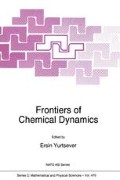Abstract
The thesis that ‘chemical reactions proceed in the most statistical way, subject to constraints’ is discussed with examples drawn mainly from direct reactions. Attention is centered on the technical aspects and their motivation, with special reference to the notions of ‘entropy’, ‘the prior distribution’ and that of the constraints. Surprisal analysis is emphasized and the Lagrangian form, which is particularly useful when several constraints are imposed, is discussed. More advanced topics such as surprisal synthesis are reviewed.
Access this chapter
Tax calculation will be finalised at checkout
Purchases are for personal use only
Preview
Unable to display preview. Download preview PDF.
References
Levine, R. D. and Bernstein, R. B. (1987) Molecular Reaction Dynamics and Chemical Reactivity , Oxford University Press.
Steinfeld, J.I., Francisco, J.S. and Hase, W.L. (1989) Chemical Kinetics and Dynamics ,Prentice Hall, New Jersey.
Smith, I.W.M. (1980) Kinetics and Dynamics of Elementary Gas Reactions ,Butterworths ,London.
Pechukas, P. (1976) Ch. 6, Statistical approximations in collision theory, in W.H. Miller (ed), Dynamics of Molecular Collision (Part B) ,Plenum Press, New York.
Jaynes, E.T. (1957) Information theory and statistical mechanics, Phys. Rev. 106,620–630.
N.F.G. Martin and J.W. England (1981) Mathematical Theory of Entropy ,Addison-Wesley, London.
Ben-Shaul, A., Levine, R.D. and Bernstein, R.B. (1972) Entropy and chemical change II. Temperature and entropy deficiency of product state distributions, J. Chem. Phys. 57, 5427–5440.
Levine, R.D. and Bernstein, R.B. (1975) Thermodynamic approach to collision processes, in W.H. Miller (ed), Modern Theoretical Chemistry ,Vol. III -Dynamics of Molecular Collisions ,Plenum, New York, pp. 323–364.
Alhassid, Y. and Levine, R. D. (1979) Experimental and inherent uncertainties in the information theoretic approach, Chem. Phys. Letts. 73, 16–24.
Agmon, N. Alhassid, Y. and Levine, R.D. (1979) An algorithm for finding the distribution of maximal entropy, J. Comput. Phys. 30, 250–259.
Levine, R.D. and Kinsey, J.L. (1979) The application of information theory to molecular collisions, Ch. 22 in Atom Molecule Collision Theory: A Guide for the Experimentalist ,Plenum, New York, pp. 693–750.
Levine, R.D. (1972) Classical evaluation of averaged collision rates, J. Chem. Phys. 56, 1633–1700.
Alhassid, Y. and Levine, R.D. (1977) Entropy and chemical change III: The maximal entropy (subject to constraints) procedure as a dynamical theory, J. Chem. Phys.67, 4321–4400.
Ben-Nun, M. and Levine, R.D. (1992) An approximate solution of the Fokker-Planck equation for reactions on condensed phases, Chem. Phys. Lett. 192, 472–480.
Kaplan, H., Levine, R.D. and Manz, J. (1976) The dependence of the reaction rate constant on reagent excitation: The implications of detailed balance, Chem. Phys. 12, 447–460.
Remacle, F. and Levine, R.D. (1993) Maximal entropy spectral fluctuations and the sampling of phase space, J. Chem. Phys. 99, 2383–2400
Remacle, F. and Levine, R.D. (1993) The domain information from resonant Raman excitation profiles: A direct inversion by maximum entropy, J. Chem. Phys. 99, 4908–5104.
Levine, R.D. (1987) Fluctuations in spectral intensities and transition rates, Adv. Chem. Phys. 70, 53–70.
Levine, R.D. (1988) Quantal fluctuations in unimolecular rate constants, Ber. Bunsenges. Phys. Chem. 92, 222–230.
Author information
Authors and Affiliations
Editor information
Editors and Affiliations
Rights and permissions
Copyright information
© 1995 Springer Science+Business Media Dordrecht
About this chapter
Cite this chapter
Levine, R.D. (1995). Information Theory Approach in Chemical Dynamics. In: Yurtsever, E. (eds) Frontiers of Chemical Dynamics. NATO ASI Series, vol 470. Springer, Dordrecht. https://doi.org/10.1007/978-94-011-0345-9_9
Download citation
DOI: https://doi.org/10.1007/978-94-011-0345-9_9
Publisher Name: Springer, Dordrecht
Print ISBN: 978-94-010-4153-9
Online ISBN: 978-94-011-0345-9
eBook Packages: Springer Book Archive

